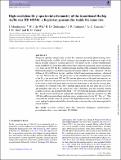High-resolution Br γ spectro-interferometry of the transitional Herbig Ae/Be star HD 100546 : a Keplerian gaseous disc inside the inner rim
Abstract
We present spatially and spectrally resolved Br γ emission around the planet-hosting, transitional Herbig Ae/Be star HD 100546. Aiming to gain insight into the physical origin of the line in possible relation to accretion processes, we carried out Br γ spectro-interferometry using AMBER/VLTI from three different baselines achieving spatial and spectral resolutions of 2-4 mas and 12 000. The Br γ visibility is larger than that of the continuum for all baselines. Differential phases reveal a shift between the photocentre of the Br γ line-displaced~0.6mas (0.06 au at 100 pc) NE from the star-and that of the K-band continuum emission-displaced ~0.3 mas NE from the star. The photocentres of the redshifted and blueshifted components of the Br γ line are located NW and SE from the photocentre of the peak line emission, respectively. Moreover, the photocentre of the fastest velocity bins within the spectral line tends to be closer to that of the peak emission than the photocentre of the slowest velocity bins. Our results are consistent with a Br γ-emitting region inside the dust inner rim (≲0.25 au) and extending very close to the central star, with a Keplerian, disc-like structure rotating counter-clockwise, and most probably flared (~25°). Even though the main contribution to the Br γ line does not come from gas magnetically channelled on to the star, accretion on to HD 100546 could be magnetospheric, implying a mass accretion rate of a few 10-7 M⊙ yr-1. This value indicates that the observed gas has to be replenished on time-scales of a few months to years, perhaps by planet-induced flows from the outer to the inner disc as has been reported for similar systems.
Citation
Mendigutía , I , de Wit , W J , Oudmaijer , R D , Fairlamb , J R , Carciofi , A C , Ilee , J D & Vieira , R G 2015 , ' High-resolution Br γ spectro-interferometry of the transitional Herbig Ae/Be star HD 100546 : a Keplerian gaseous disc inside the inner rim ' , Monthly Notices of the Royal Astronomical Society , vol. 453 , no. 2 , pp. 2126-2132 . https://doi.org/10.1093/mnras/stv1777
Publication
Monthly Notices of the Royal Astronomical Society
Status
Peer reviewed
ISSN
0035-8711Type
Journal article
Description
ACC acknowledges support from CNPq (grant 308985/2009-5). JDI gratefully acknowledges funding from the European Union FP7-2011 under grant agreement no. 284405. RGV acknowledges the support from FAPESP (grant 2012/20364-4).Collections
Items in the St Andrews Research Repository are protected by copyright, with all rights reserved, unless otherwise indicated.

